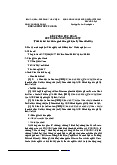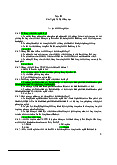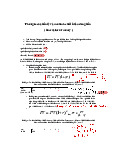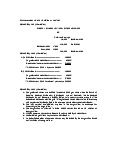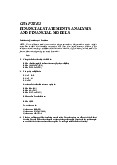



















Preview text:
Global Agenda Data Driven Cities 20 Stories of Innovation
Prepared by the Global Future Council on Cities and Urbanization October 2017 People Economy Governance Infrastructure Environment Contents Introduction 6 People 7
1. Showing at a glance if city services are meeting their targets 8
2. An easier way to get help if you’re harassed on public transport 9
3. Complain about city services – and get notified of results 10
4. Better productivity through understanding local workplace cultures 11 Economy 12
5. Leading the way on blockchain – can it improve city services? 13
6. Opening up data to improve policymaking and encourage innovation 13
7. Understanding city economics by analysing bank data on spending 14
8. A seamless public transport experience – paying by card or face recognition 14 Governance 15
9. Citizens participate in making the city budget 16
10. Easy access to al relevant information on planning issues 17
11. World’s first public-facing crime forecasting platform 18
12. GIS tracks unplanned settlements – and empowers their inhabitants 19 Infrastructure 20
13. Tackling congestion in partnership with taxis and navigation apps 21
14. Reducing wastewater, improving treatment – and using sewage to power 22 cars
15. Telemedicine via tablets helps first responders to reduce unnecessary 22 hospital visits
16. Improving tourist attractions by tracking how visitors use them 23 Environment 24
17. Environmental impact through design 25
18. Engaging citizens to map urban trees – and advocate for more 25
19. Dynamic signs and intel igent street lights make cyclists’ lives easier 26
20. Data helps cities to prepare for natural disasters – and respond 26 Conclusion 27
Data driving Cities: 20 Stories of Innovation 3 Introduction
The Fourth Industrial Revolution is set to erupt in cities
The fol owing pages present stories from cities al over the
throughout the world. Bits are meeting bricks as the internet
world, selected by a diverse panel – from academia to
enters the spaces we live in, becoming the Internet of
industry to government. These are stories of innovation that
Things. The results wil impact most aspects of our lives,
is occurring in the developed and the emerging world, from
raising questions of urgent concern. Which dimensions
the top down and the bottom up, design-led efforts and
of cities wil be most affected? What wil be the impact on
new policy initiatives. The common thread that connects
citizens? How should urban policy change? And, most
them: the chal enges cities face as they approach the Fourth
importantly, how can cities prepare for looming disruptions Industrial Revolution. and opportunities?
The stories il ustrate how data can be used to improve the
This report by the World Economic Forum’s Global Future
experience of the built environment – whether by public
Council on Cities and Urbanization looks at these questions
entities, large corporations, startups, or private citizens.
through a very specific lens: data. The convergence of the
Using data, we can better understand the digital world in
digital and physical worlds is producing an immense amount ways that enable us to transform physical space. We can
of information, as much information was created in 2016 as
develop solutions to tackle some of the most pressing
in al of previous human history.
issues – from energy to waste, from water to mobility, from
urban design to citizen participation.
Citizens leave their digital trace just about everywhere they
go, both voluntarily and involuntarily. Each phone cal , text
The stories presented in this report are classified into five
message, email, social media post, online search and credit
themes: people, governance, infrastructure, economy
card purchase is recorded and stored in the cloud. When
and environment. They provide a glimpse of the impact
cross-referenced with each user’s geographical location,
of the Fourth Industrial Revolution on cities through the
data harnessed at this scale offers a means of describing,
unprecedented lens of data – arguably, our newest urban
and responding to, the dynamics of the city in real time. common.
Not al data is created equal, and its variety is also part of this report:
– “Opportunistic data” is col ected for one purpose and
then used for another: think about data owned by
cel phone companies to run their operations, and used
by transportation companies to better understand urban mobility.
– “Purposely-sensed data” shows the power of cheap
and ubiquitous sensors that can be deployed ad hoc
– in private buildings or in public spaces – to better
understand some aspect of urban life.
– “User-generated data” comes from engaging
people, such as through social media platforms or
crowdsourcing. Every tweet, Facebook post, or Flickr
upload can provide valuable information to better
understand today’s cities and society. 6
Data driving Cities: 20 Stories of Innovation People
“What is the city but the people?” asked Shakespeare. Today,
new technologies are giving citizens more opportunities to have a
say in the functioning of their communities. They are opening up
a space – in the convergence of the physical and the digital – in
which people can organize to reclaim what French philosopher
Henri Lefebvre called their “right to the city”. The data stories
collected in this chapter are linked by their interest in provoking
behavioural change, whether people-to-people or government-to- people.
Unlike the broad, sweeping projects of the past, digital changes
can happen without heavy infrastructure. They are not necessarily
determined by governments, but can arise from bottom-up
actions. Public institutions should want citizens to get excited
about urban innovation. Beyond the installation and control of
hardware, if the right platforms can be developed, people can
really be the ones to transform the cities they own.
Data driving Cities: 20 Stories of Innovation 7
1. Showing at a glance if city services are meeting their targets What How
CityScore is an online dashboard showing how Boston’s
Some data is automatical y col ected by sensors, such as
city government is performing against its targets in 24
the percentage of buses arriving on time. In other cases,
areas – from sign placement to emergency cal response,
city workers use their mobile devices to record when they
from garbage col ection to pothole repairs. Daily activity
have completed a task. Then, this data is automatical y
updates make performance and progress transparent to the
aggregated and divided by the target figure to generate a
public and city administrators. A single, combined number
daily, weekly or quarterly score: above 1 means the city is
summarizes how the administration is performing overal .
exceeding its targets, below 1 means it is fal ing short. Why Potential
The metrics measured by CityScore are a gauge of how
An open-source version of the CityScore platform is
wel the city government is serving its citizens. Tracking
available on GitHub for other cities to adopt and adapt,
performance against targets enables problem areas to
offering the potential to engage citizens and improve
be quickly identified and remedied, and offers citizens the services around the world.
opportunity to hold administrators to account. It would
historical y have been much more chal enging to col ect and Useful links
review the necessary data manual y.
https://www.boston.gov/cityscore
Boston’s cityscore dashboard lets citizens know how wel their city is performing on a wide range of metrics 8
Data driving Cities: 20 Stories of Innovation
2. An easier way to get help if you’re harassed on public transport What
Bájale al Acoso is a mobile platform used to report sexual
harassment cases that occur on the municipal public
transportation system in Quito, Ecuador. Why
Some 83% of women who live in Quito consider the public
transportation unsafe – far more than the 6% who make a
formal complaint about sexual harassment. The platform
is part of Quito, A Safer City for Women and Girls, a joint
initiative of UNIFEM and Patronato San José, a local social foundation. How
The platform uses SMS, as most women who use public
transport do not have a smartphone. Anyone who feels at
risk of sexual harassment can send an SMS describing her
concern and where she is: a central service aims to respond
within three minutes, for example by activating an alarm
on the bus or dispatching a public official to wait at the
next bus stop. Six “safety spots”, with specialized staff, are
located at the main bus stations; 220 bus drivers have been
trained in responding to incidents of harassment. Potential
By col ecting data, the platform promises to inform better
policies and make responses more efficient, thus optimizing
predictive systems and better at targeting police attention. It
also raises awareness of the problem of sexual harassment
on public transport, which should contribute to changing
social attitudes about its acceptability. Useful links http://www.bajalealacoso.com
Data driving Cities: 20 Stories of Innovation 9
3. Complain about city services – and get notified of results What Potential
The “Our City” portal makes it easy for citizens in Moscow,
As wel as improving the efficiency of infrastructure and
Russia, to submit requests or complaints about city services services, the data generated by such platforms could help to
– for example, about street cleaning, garbage col ection,
prevent problems by informing better on-time maintenance
or potholes – and receive updates when the issue is or management decisions.
addressed. The portal also shows a map of where citizens
have submitted requests and complaints. Useful links
https://www.mos.ru/en/news/item/13030073/ (eng) Why
Citizens often do not know what services the city provides,
or how to request them. Administrators may not be aware of
problems unless citizens report them, and may not receive
due credit for addressing them. How
Citizens can submit complaints via the online portal or a
mobile app. In each case, the citizen briefly explains the
problem and, optional y, attaches photos. Then, the case is
automatical y assigned to a subcontractor or city authority
that has strict rules regarding time frames for resolution.
Final y, citizens receive a personalized response when the
problem is fixed, typical y with photos of the result.
In its first year, Our City portal has already registered nearly 1.1 mil ion users, and delivered over 2 mil ion complaint resolutions 10
Data driving Cities: 20 Stories of Innovation
4. Better productivity through understanding local workplace cultures What How
As the global economy continues to prioritize innovation and The workplace surveys gathered data via an online panel
knowledge work, understanding the drivers of employee
of over 11,000 office workers distributed evenly across the
performance and a balanced workplace becomes a more
US, UK, Asia and Latin America using Gensler’s Workplace
critical component of economic growth and discovery.
Performance Index platform. Respondents have worked
Data from multiple surveys featuring more than 11,000
in an office environment at least some of the time, and for
office workers in different markets around the world
a company of at least 100 people. The obtained data was
has uncovered new insights into how different working
analysed by an internal research team using higher order
conditions are needed to optimize human performance in
inferential statistical methods and tools such as multiple
different regions and cultures.
regression and ANOVA, along with descriptive analytical
methods such as quartile and segmentation analysis. Why
There have long been cultural stereotypes about how office Potential
workers in different cultures like to work differently. North
City governments and business leaders can use the data
Americans, for example, seem to prefer individual focus
from such surveys to foster productivity and innovation by
work, while Latin American and Asian knowledge workers
tailoring strategies toward the needs of the local population,
are more likely to col aborate to improve productivity. But
rather than importing business and cultural models that
is there truth in the stereotypes? Understanding if and how seem to work elsewhere.
different dynamics shape work environments in different
cities could enable employers to optimize workspaces according to local culture.
Gensler Workplace Surveys develop an understanding of how and where people are working, and how wel their spaces support that work
Data driving Cities: 20 Stories of Innovation 11 Economy
The Fourth Industrial Revolution will change how we produce and
consume, and its impact on city life will be dramatic – from new
forms of manufacturing to artificial intelligence and the sharing
economy. Digitally controlled machines, 3D printers, open-source
software and new sharing devices allow almost everyone to draw
and give shape to their own products, ideas, houses, or working
spaces, often using data to personalize their experience of the built environment.
As they strive to attract foreign and direct investment, talent,
skilled labour and startups in the era of the Fourth Industrial
Revolution, cities must remodel their economies to become
attractive for what Elizabeth Currid-Halkett calls the “aspirational
class”. Members of this multiform, peripatetic class are interested
in “inconspicuous consumption” – for example, good schools,
wellness facilities, and a thriving cultural and food scene. 12
Data driving Cities: 20 Stories of Innovation
5. Leading the way on blockchain 6. Opening up data to improve
– can it improve city services? policymaking and encourage innovation What What
Dubai launched a citywide blockchain strategy in 2016.
Dublin and Melbourne are among cities leading the way
Beginning with pilots in 2017, it is exploring the extent to
in making their data publicly available for businesses and
which implementing blockchain technology in government
citizens to use, as wel as providing tools for visualization
services can improve their efficiency. The strategy also
and analysis. Melbourne decided to make available data
aims to create an enabling environment for startups in the
it has col ected for many years on areas such as land use blockchain industry.
and pedestrian movements; Dublin’s website Dublinked is a
partnership of local authorities and the National University of Why Ireland.
Many believe that blockchain – the technology behind
cryptocurrencies such as Bitcoin and Ethereum – has the Why
potential to transform large sectors of governance and the
City governments use data to inform the making of policies
economy by eliminating the need for centralized third parties and decisions. Opening up that data to the general public
to monitor and validate transactions. However, analogously
is intended to drive innovation and col aboration in the
to the early days of the internet, exactly how the potential
development of new urban solutions. Dublinked, for
of blockchain wil play out remains a matter of some
example, has led to the formation of startups and launching uncertainty. of new software applications. How How
Visa applications, bil payments, license renewals, health
The data comes from various sources: in Melbourne,
records and property transactions are among the services
examples include revaluations of property for taxation
the city is starting to put on the blockchain, moving towards
purposes and remote digital counting of pedestrian
integrating blockchain technology as much as possible
movements. Dublinked has over 250 data sets covering
by 2020. The strategy to encourage the private sector to
areas from planning and land use to recreation and
adopt blockchain technology includes accelerators and
amenities; public and private companies can also share their
competitions, with a council comprised of approximately 50
data on the website, alongside the data provided by local
members from private sector and the formation of cross- authorities. border partnerships. Potential Potential
As more cities emulate Melbourne and Dublin by creating an
Dubai’s government hopes to save significant amounts
open data culture, more citizens and startups are expected
of time and money by adopting blockchain, and its
to find ways to use the data to improve city services and
experiences should be transferable to other cities.
create economic and social value. Useful links Useful links
http://www.smartdubai.ae/dubai_blockchain.php
https://data.melbourne.vic.gov.au/about http://dublinked.ie/
Data driving Cities: 20 Stories of Innovation 13
